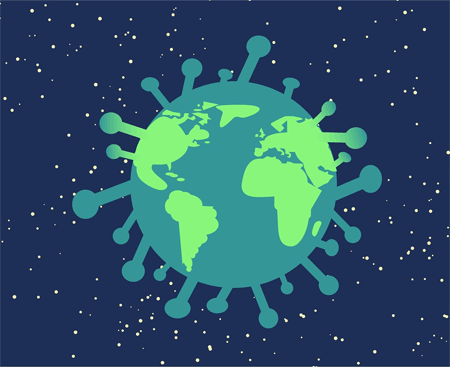The psychological impact of the events of 2020: effects that may last for a very long time
As Center Director Jeffrey Cole explains, the 2020 coronavirus pandemic combines three of the worst years in American history: 1918, 1933, and 1968.
By Jeffrey Cole
Our recent Coronavirus Disruption Project is full of countless trends, insights, and numbers.
One number stands out from the rest: 37%. That’s the percentage of Americans who—even after a vaccine is found and the pandemic fades away—plan to reduce their face-to-face contact with other people.
 Once we feel safe (if we ever do) we may quickly revert back to old habits and behaviors. But, in the middle of the pandemic, more than one-third of Americans think they will be uncomfortable in large gatherings, crowded public transportation, packed beaches and swimming pools, shoulder to shoulder in bars and restaurants, full stadiums, theme parks, and movie theaters.
Once we feel safe (if we ever do) we may quickly revert back to old habits and behaviors. But, in the middle of the pandemic, more than one-third of Americans think they will be uncomfortable in large gatherings, crowded public transportation, packed beaches and swimming pools, shoulder to shoulder in bars and restaurants, full stadiums, theme parks, and movie theaters.
Air travel may represent more than an inconvenience: we may feel anxious in long security lines and sitting uncomfortably close to dozens of other people in a long tube for hours.
In short, 37% will view other people as a potential threat.
Three years
What we are seeing in this 37% figure is the psychological long tail of Coronavirus. Our psyches will carry the toll of the virus long after our bodies are safe. When people are thrust into dangerous situations that put their lives at stake and where they lack control, (soldiers, victims of crime, plane crashes) Post Traumatic Stress Disorder (PTSD) commonly follows.
PTSD follows an intensely stressful event. Common symptoms include invasive memories, flashbacks, intense feelings of distress, and avoiding certain activities. All the disorders that the pandemic has brought—fears for our safety and that of our loved ones, our economic and job security, foreboding about the future of the world—will linger for a long time.
When it comes to creating stress and foreboding, 2020 is turning out to be a perfect storm, combining three of the most difficult years in American history.
1918: With the Coronavirus pandemic, we have been reliving the Spanish Flu pandemic of 1918. Books about the 100-year-old flu have catapulted to the top of best-seller lists, and movies about it top Netflix’s most-watched list. We are looking for the parallels in how the flu started, continued to infect, and then eventually disappeared.
1933: The economic toll of joblessness and despair from Coronavirus is also bringing up a psychological return to the year 1933—at the height of the Great Depression. Few are around who remember those years, but almost all of us are the children and grandchildren of those who lived through this period.
The 1918 and 1933 parallels have been clear since early March.
Then came the killing of George Floyd by a police officer in Minneapolis.
1968: The tragic and unnecessary killing of George Floyd and the resulting demonstrations and unrest in cities across the country raise difficult memories of 1968. That was the year when the nation’s campuses and cities felt like they were on fire because of demonstrations against the Vietnam war.
Things got worse following the assassination of Martin Luther King. The demonstrations culminated in the streets of Chicago at the Democratic National Convention and led to the election of the “law and order” candidate, Richard Nixon.
___________________________________________________________________________
Now and for the foreseeable future, we are more likely to view other people (particularly strangers) as a danger or a threat. Today, over one-third of us believe even when the vaccine comes we will want to keep distance from others. This may be the lasting legacy of the pandemic. If it is, and if we don’t revert back to life as it was B.C., the changes in our social, economic, and political lives will be unlike anything we have ever seen.
___________________________________________________________________________
I’m writing this column at the beginning of June 2020. It is not clear if the current demonstrations will diminish and fade away in a week or grow and spread throughout the year and election season—on par with 1968. Now that the main police officer involved has been arrested, it raises worrisome fears and reminders of the aftermath of a non-guilty verdict in the trial of the police officers who nearly beat Rodney King to death in 1991.
We have had difficult years before (1941, 2001), but never in our 231-year history as a country have we lived through three of the most difficult years rolled into one.
In the early days of the Coronavirus pandemic, before we could see the full economic devastation and the coming police brutality and demonstrations, anxiety was at record levels among Americans. In mid-April, the Center’s Project saw that 62% of people were feeling more anxious, with 19% feeling much more anxious. Only 4% were feeling less anxious.
If anything, these numbers have grown over the past few weeks as the memories of 1933 and 1968 have entered our psyches.
This is, we believe, the lasting legacy of 2020: we may carry the fear and apprehension with us the rest of our lives.
We have seen other examples of anxiety and fear remaining in our psyches many years after the events themselves. My father grew up during the Depression. Although few felt they would die because of it, the toll on lives resembled a pandemic. Even 50 years later, long after my father had become a successful businessman, he carried the psychological reminders of 1933. He could never waste money and saved a very high percentage of his income—never comfortable spending it. The security was in having it.
To my father, a job was not something you had for fulfillment but how you supported your family. Shortly after college, I gave up a good job to follow the things I really wanted to do. While Dad was supportive, he could never really understand my willingness to take that risk.
B.C. and A.C.
A pandemic, a depression, and now, mass demonstrations and civil strife, make a perfect trifecta. For a long time, perhaps the rest of our lives, we will split our reckoning of history between “B.C.”—before Corona—and “A.C.”—after Corona.
Some of the things that Americans currently say they might soon want to do (like going to sporting events and concerts, movies, restaurants) might be too pleasurable or necessary for us to refrain for very long. Work and school may force us to do uncomfortable things like take public transportation or sit in classrooms or lecture halls. We may wait longer before we go into theaters or theme parks. Ultimately, these things are likely to return too, although with new rules and perhaps some social distancing.
A resurgence of cases or a different pandemic would raise these changes and fears into the stratosphere. Even if Coronavirus is the most dangerous pandemic of our lifetimes, something hugely important has changed, probably for a very long time.
The pandemic arrived in a country that is more divided than it has been in decades. The last three years, no matter which side you feel close to, has exacerbated those differences. Now we have been hit hard by an economic depression and civil unrest. It seems more than we can take. This will lead us to stay closer to home, narrowing our relationships to those we know and love the most and could reduce our empathy for people we don’t know. This is yet another effect of post-traumatic stress.
Now and for the foreseeable future, we are more likely to view other people (particularly strangers) as a danger or a threat. Today, over one-third of us believe even when the vaccine comes we will want to keep distance from others. This may be the lasting legacy of the pandemic. If it is, and if we don’t revert back to life as it was B.C., the changes in our social, economic, and political lives will be unlike anything we have ever seen.
____________

Jeffrey Cole is the founder and director of The Center for the Digital Future at USC Annenberg.
See all columns from the center.
June 2, 2020

